This guide will take you through the newly merged Dong Thap province, which from July 2025 now includes Sa Dec, Cai Be and My Tho, making it a destination that combines lotus-filled wetlands, colorful flower villages, floating markets and riverside pagodas. You’ll find everything you need to plan your trip: when to visit, how to get there, must-see sites, local dishes to try and unique souvenirs to bring home. Whether you’re drawn to the tranquil beauty of the lotus ponds, the excitement of Cai Be’s markets, or the cultural charm of My Tho, this guide will help you experience the best of the Mekong Delta in one unforgettable journey.
General information
The newly expanded Dong Thap province, including Sa Dec, Cai Be and My Tho, has become one of the most diverse destinations in the Mekong Delta. This land combines the iconic lotus fields of Thap Muoi with the flower gardens of Sa Dec, the bustling floating markets of Cai Be and the unique culture of My Tho. All create a province where the rural beauty, vibrant river life blend with history and tradition.

Lotus fields, the symbol of Dong Thap
Dong Thap stands out with the land of lotus – the symbolic flower and also the national flower of Vietnam. Coming here, you will admire the fragrant lotus fields, the vast rice fields and especially the giant lotus flowers where adults can even stand on the leaves. During the flood season, the landscape here is even more vibrant, ideal for ecotourism. In addition, Dong Thap also impresses with its ecological diversity, a place that preserves many cultural and historical values, with traditional festivals, local handicraft villages and rich specialties.
Sa Dec, often referred to as the “city of flowers,” is famous for its colorful gardens and French colonial architecture, while Cai Be is home to one of the Mekong Delta’s most iconic floating markets. My Tho, on the other hand, serves as the gateway to the Mekong River, with its orchards, riverside islands, and the stunning Vinh Trang Pagoda. The combination of natural scenery, cultural diversity, and vibrant towns makes Dong Thap the perfect destination in the heart of southern Vietnam.
Weather and best time to visit
Like many other parts of the Mekong Delta, Dong Thap province has a tropical monsoon climate, which is warm and humid all year round. Average temperatures range from 25–32°C (77–90°F), with two main seasons: dry and rainy. You can visit all year round, but the dry season is the best time to visit Dong Thap. The sunny skies, low humidity, and cooler evenings are perfect for sightseeing, boating, and cycling through flower villages and orchards. December to February is particularly beautiful, when the Sa Dec flower gardens burst into bloom before Tet, and the lotus ponds of Thap Muoi are in full bloom, among other festivals.

The floating season in Dong Thap
The rainy season lasts from May to October, with daily afternoon showers that can be heavy but are usually short-lived. Although some visitors shy away from visiting at this time, it does have some upsides. This is the “flood season,” with rising river waters bringing activities like riverboats and floating markets to life, fishermen casting nets in flooded fields, and bird sanctuaries like Tram Chim teeming with life.
How to get to Dong Thap
Dong Thap is located about 150–170km from Ho Chi Minh City and nearly 1,900km from Hanoi. With a convenient transportation system, you can choose from many different means of transport to get to this lotus land.
By plane
Although Dong Thap does not have a commercial airport, it is conveniently connected by neighboring centers. Can Tho International Airport is the closest option, only about 60km from Sa Dec with regular domestic flights from major cities such as Hanoi, Da Nang and Ho Chi Minh City, along with an increasing number of international flights. From the airport, you can easily arrange a private transfer or catch a bus to Dong Thap. Another option is Tan Son Nhat International Airport (HCMC), which serves as the main gateway for international visitors before continuing by road to the province.
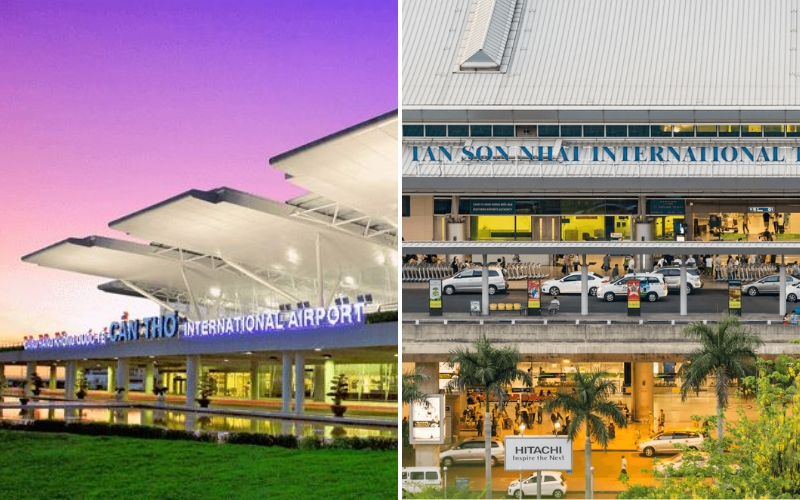
Main airports serving in Dong Thap
By water
Traveling by boat is not only convenient in the Mekong Delta but also brings the most unique and memorable experiences. From My Tho, you can join a cruise tour on the Mekong River, stopping at small islands and fishing villages along the river before reaching Cai Be floating market. From there, it is easy to travel to Sa Dec or Dong Thap towns. This route is especially popular with tourists who want to experience local life along the river instead of just taking the highway.
By bus
This is the most popular and convenient option. You can buy a bus ticket to Dong Thap at Mien Tay Bus Station or reputable bus offices such as Phuong Trang, Mai Linh, Kim Cuong, Dong Phat, Phu Vinh, … There are many types of vehicles for you to choose from such as seats, beds, limousines, with a travel time of about 3-4 hours from Ho Chi Minh City.
By personal vehicle
If you love freedom and want to fully enjoy the beauty of the West on every road, traveling by motorbike or personal car is the ideal choice, with a very easy and convenient highway system. But you need an international driving license and be a little careful with local traffic laws.
How to get around
By boat
Taking a boat tour is the most authentic way to explore Dong Thap and the Mekong Delta. Gliding past Cai Be floating market, the orchards of My Tho, or quietly drifting past lotus ponds and bird sanctuaries in the wetlands of Dong Thap will certainly add to the experience. Many homestays and local guesthouses offer small wooden boats, giving you a slow, close-up view of river life that cars can’t offer.
By bicycle or motorbike
For those who love freedom, renting a bicycle or motorbike is the perfect way to travel between peaceful villages and orchards. Motorbikes also allow you to explore more places, especially if you plan to explore both towns and countryside in a day. Rentals are very cheap, averaging around $4 a day for motorbikes and around $2 for bicycles.
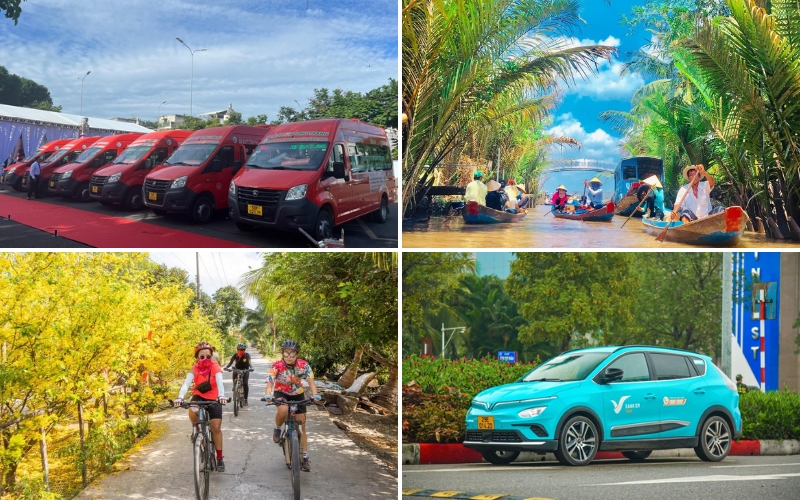
Main transportations for moving around Dong Thap
By car or taxi
If you need to travel between major cities such as Sa Dec, My Tho and Cai Be, a car or taxi is the most convenient way. You can book through the hotline of the car companies or book through booking apps such as Grab, Xanh SM.
By local bus
If you find travelling by car expensive, take a local bus or minivan, which connects major towns and small districts across the province. This is not the fastest way to travel, but it is more economical and gives you the opportunity to sit among the locals, enjoy the fresh air and watch daily life outside the window.
Best places to visit in Dong Thap
Dong Sen Thap Muoi Ecotourism Area
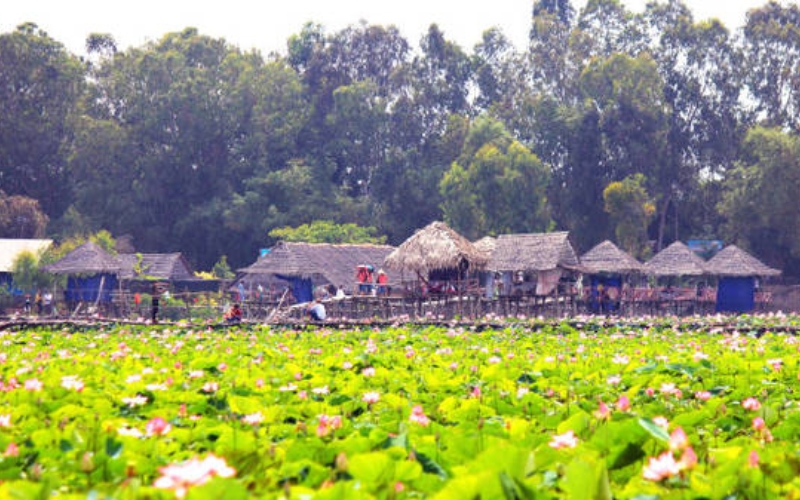
The beautiful lotus lake in full bloom season
Located in a peaceful area, 39km from the city center, this place owns 11 hectares of ponds and lakes full of pink lotus, interspersed with immense rice fields. Coming to Dong Sen Thap Muoi, you will be able to take a wooden boat to row through the lotus fields, experience picking lotus, catching fish, and take advantage of the moments to take beautiful and unforgettable photos. Experience the feeling of sitting in the middle of the immense pink lotus field, enjoy the peace of nature and enjoy unique dishes made from lotus, Dong Sen Thap Muoi Ecotourism Area will be a destination that will not disappoint you.
Cai Be Floating Market
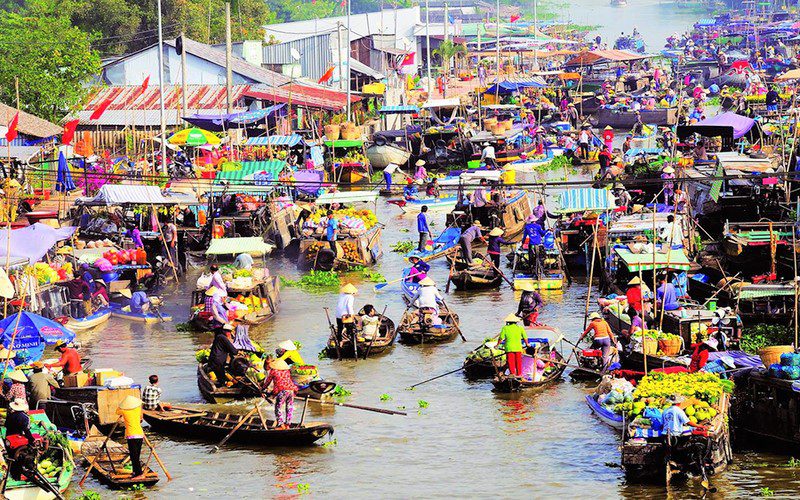
Cai Be Floating Market
This is one of the six most famous and oldest floating markets in the Southwest, established under the Nguyen Dynasty in the 19th century. Boats of all sizes carrying hundreds of different types of goods are the only means of transportation here. The beauty of the Mekong River in the West of our country will make visitors fascinated by the extremely vibrant atmosphere of boats selling all kinds of goods from fruits, clothes, food.
Sa Dec Ornamental Flower Village
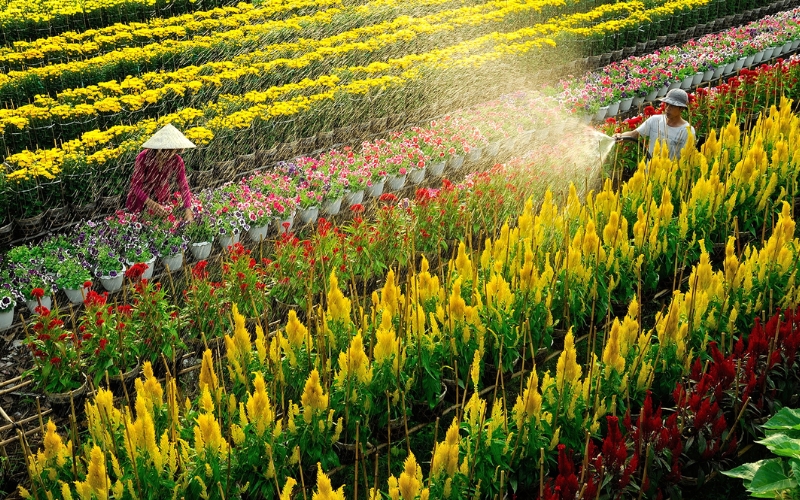
Bird’s-eye view of Sa Dec flower village
Sa Dec Ornamental Flower Village is a famous destination with countless species of ornamental flowers. With a history of more than a century, Sa Dec Ornamental Flower Village has become a cultural and tourist symbol of the Dong Thap Muoi region. In the spring, Sa Dec Ornamental Flower Village becomes even more brilliant with unique ornamental flower festivals, attracting a large number of tourists to visit and participate. With its natural beauty and sophistication in ornamental flower decoration, Sa Dec Ornamental Flower Village is an attractive destination for those who love nature, art and want to experience the unique beauty of the Dong Thap region.
Tram Chim National Park
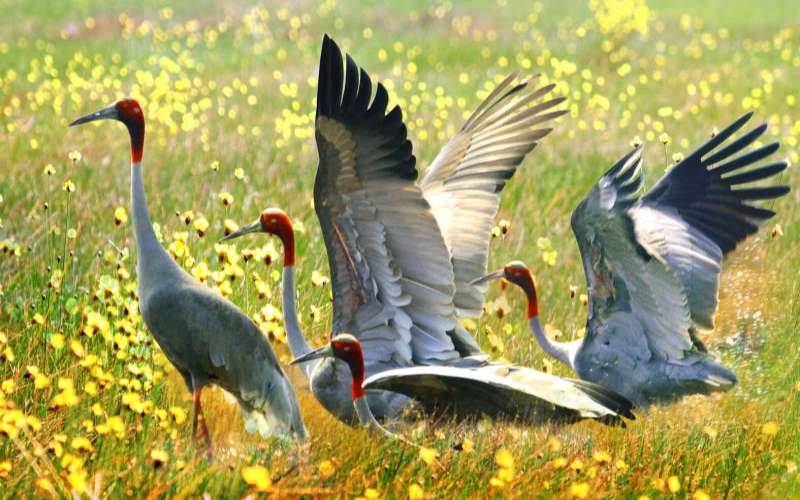
Rare Sarus Cranes at Tram Chim National Park
Tram Chim National Park is a nature reserve located in the Dong Thap Muoi wetland system. This is a common home and an important stopover in the migration journey of thousands of birds, including rare and endangered species. A boat trip here will take you through flooded forests, lotus fields and canals alive with fish and waterfowl. Tram Chim National Park is considered a paradise for those who love to observe and study wildlife and nature.
Vinh Trang Pagoda
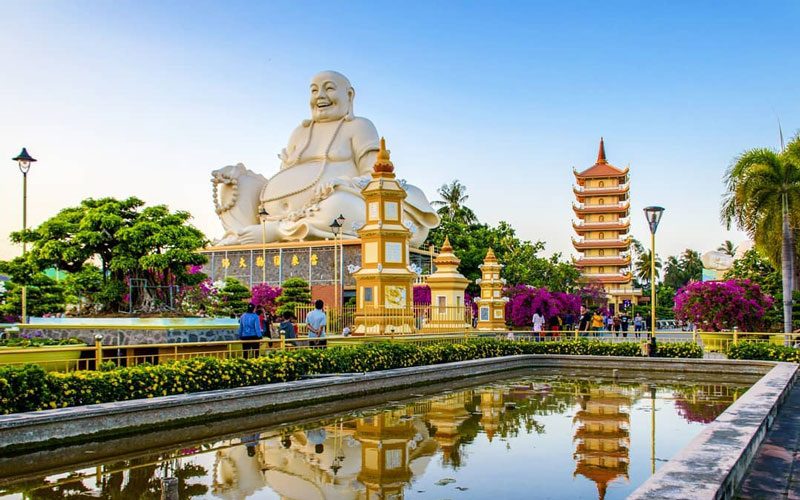
Vinh Trang Pagoda
This pagoda was built in 1849 and is the largest Buddhist temple in the area, and is also the most famous tourist destination in My Tho. With a total area of 2,000m2, the architecture of the pagoda is a combination of the quintessence of Chinese, Vietnamese, Khmer and European styles. The pagoda has three massive Buddha statues in the yard: standing Buddha, Maitreya Buddha and reclining Buddha. This stunning mixed-use structure consists of five buildings, two ornamental buildings and 178 pillars decorated with impressive woodwork and sculptures, such as a set of eighteen Arhats created by several artists.
Thoi Son Islet (Unicorn Islet)

Thoi Son Islet in My Tho
This is the largest of the surrounding islands, with a total area of about 660ha. Many organized tours departing from Ho Chi Minh City stop here for lunch and fruit. Narrow canals allow boats to navigate the interior, gliding gently on the slender streams, shaded by beautiful water palms that intertwine to form cathedral-like domes, you will easily feel like you are exploring a new land. Bright blue kingfishers and gorgeous butterflies add to the romance. Nowadays, tourism is booming on the island, so locals can run some tourism businesses, such as providing homestays or taverns serving local cuisine, or selling tropical fruits from orchards.
Xeo Quit Relic Site

Exploring Xeo Quyt by sampan boat
Xeo Quit combines history and nature in one fascinating destination. Once a Viet Cong base during the Vietnam War, this place is now an eco-tourism destination, where visitors can hike or take a sampan through shady Melaleuca forests and canals. The bunkers and relics remain silent witnesses to history, making this a peaceful and thoughtful stop.
Orchards
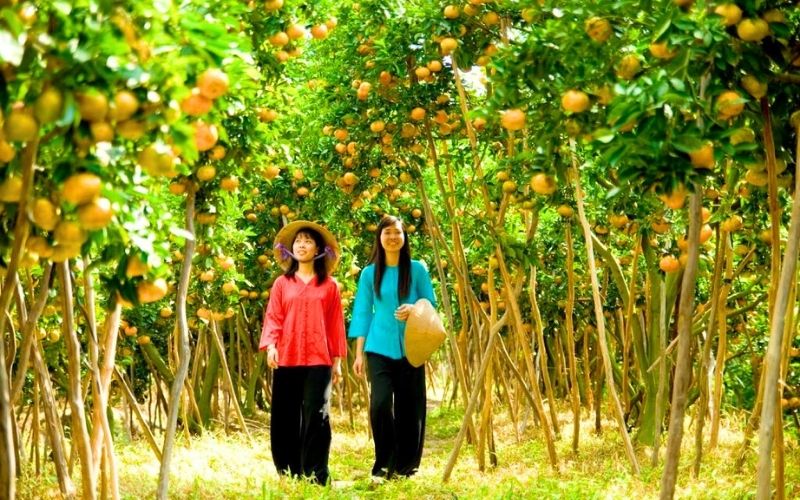
Cho Lach Orchard
Thanks to the fertile riverside land, rich in alluvium, and favorable climate and natural conditions, the fruit trees here are always lush, blooming all year round. In particular, they have a sweet and juicy taste. Visiting these gardens, you will get lost in a large, green orchard, enjoy delicious fresh fruit and enjoy the unique fresh air. In particular, inside the garden there is also a food court, serving many Western specialties such as grilled snakehead fish, fish sauce hotpot, fried elephant ear fish,… with extremely delicious flavors and extremely affordable prices.
What to eat
Grilled snakehead fish
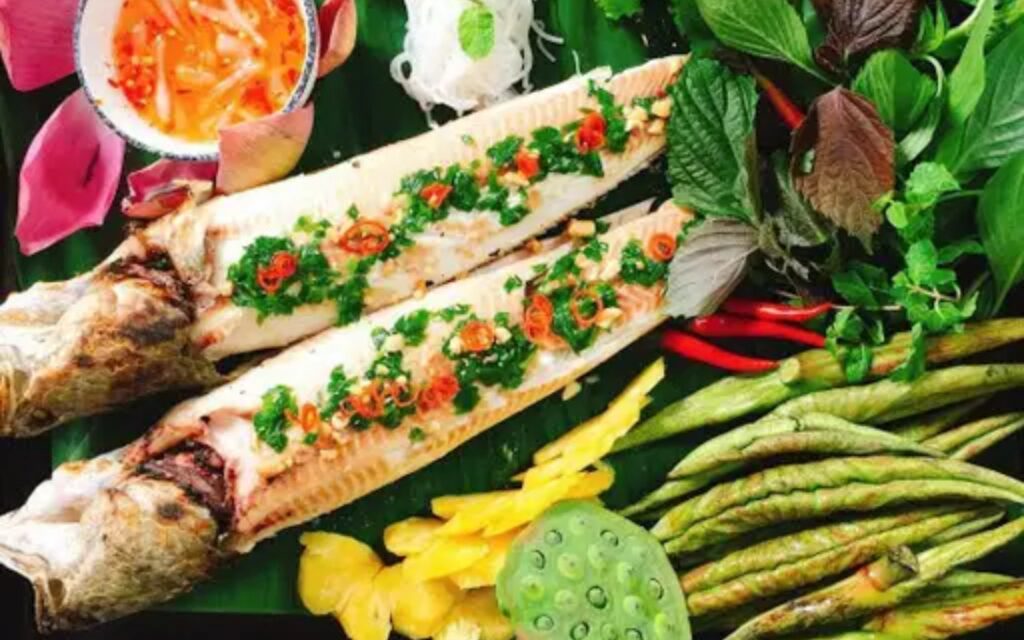
Grilled snakehead fish
This is a specialty dish of the South in general and Tien Giang in particular, with delicious flavors coming from special ingredients and unique processing methods. For the dish to be delicious, the fish must be grilled until golden brown, served with spring rolls, raw vegetables, rice noodles and cucumbers. The dipping sauce for this dish is also very simple, consisting of only salt, chili, pepper, or fish sauce, chopped star fruit, lemon juice, sugar and chili.
My Tho noodles
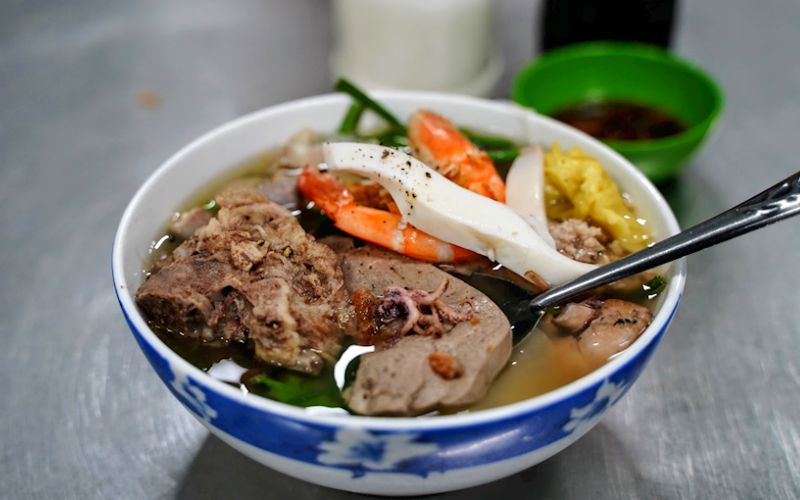
My Tho noodles
This is a traditional dish of the My Tho people, in the Mekong Delta. This noodle dish was introduced to this region in the 17th century, with the name of ancient Chinese noodles, and became popular in M’Tho since the 1960s. The ingredients of the dish include rice noodles, various fillings and locally prepared broth. The noodles are made from the local Go Cat rice variety, creating a crispy and slightly chewy texture. The fillings often include minced garlic, minced pork, quail eggs, shrimp, pork liver and lemon juice.
Dong Thap Lotus Brown Rice
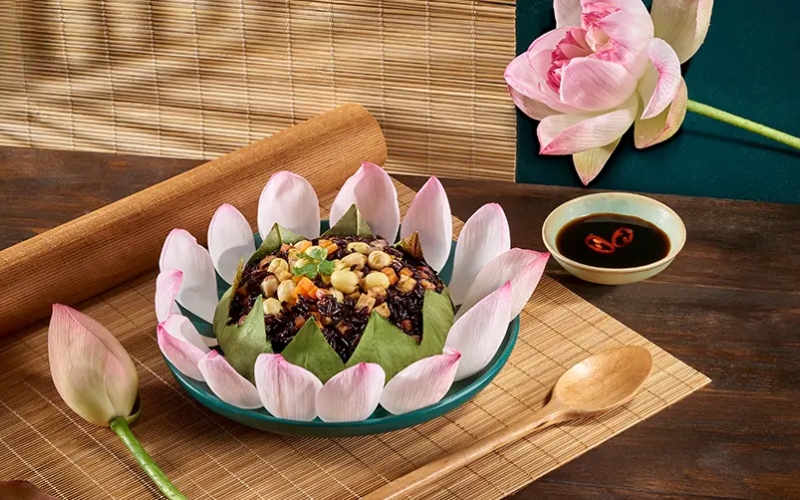
Lotus brown rice
Lotus is the soul of Dong Thap, and you’ll find it in everything from tea to snacks. One of the most popular dishes is lotus brown rice, a delicious bowl of brown rice mixed with young lotus seeds. Rich, fragrant and slightly sweet, this dish is both healthy and a local specialty, often served with vegetables and fish.
Fresh lotus sprouts mixed with shrimp and meat
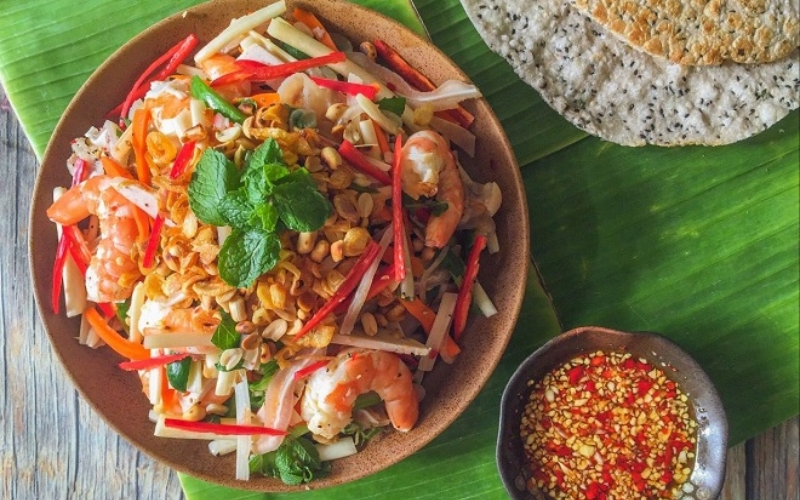
Fresh lotus sprouts mixed with shrimp and meat
Fresh lotus root is crunchy, refreshing and slightly sweet. In this salad, lotus is mixed with boiled shrimp, sliced pork, herbs and sweet and sour fish sauce. Served with sesame rice paper, this is a light but rich dish, perfect for warm days.
Fruits

Tropical Fruits
Dong Thap province is also one of the richest fruit producers in Vietnam. My Tho is famous for its creamy star apples, while Cai Be is home to some of the best mangoes in the country. Stroll through the orchards and you will find longan, rambutan and durian depending on the season. Enjoying the fruit straight from the orchard is part of the local experience.
This guide will reveal what awaits you, from the colors, the culture, to the peaceful pace of river life. With the lotus fields of Thap Muoi, the flower villages of Sa Dec, the bustling markets of Cai Be, and the riverside charm of My Tho, Dong Thap is the destination that captures the soul of the Mekong Delta. Here, every dawn brings the scent of flowers, every ferry ride tells a story, and every meal connects you to the land and its people. If you’re ready to experience the Mekong Delta at its most authentic and captivating, contact us today to create your perfect Dong Thap itinerary.